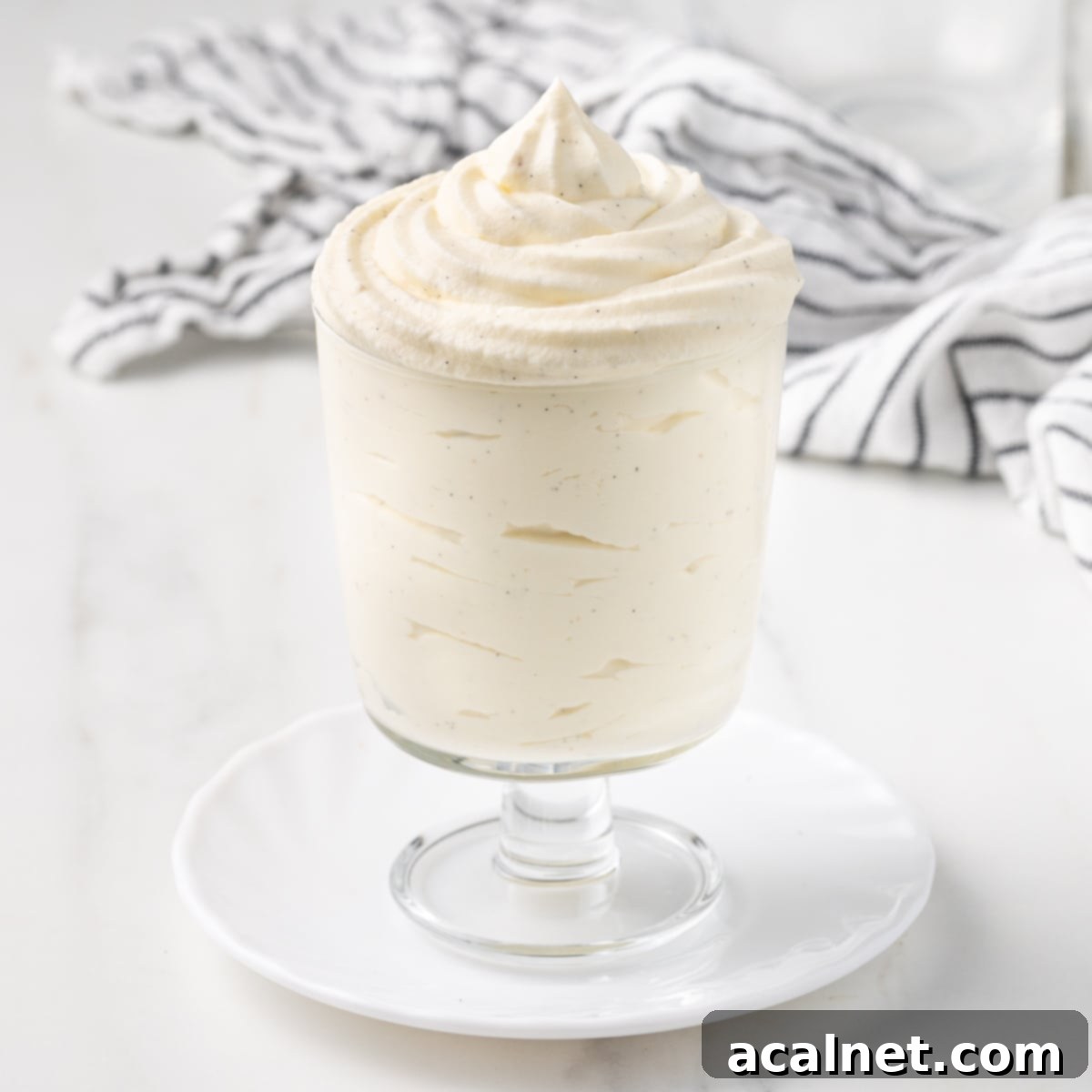Ultimate Crème Chantilly Recipe: Easy Homemade Vanilla Whipped Cream for Desserts
Elevate your desserts with this incredibly quick and easy **Crème Chantilly** (also known as Chantilly Cream) recipe. Crafted with just three basic ingredients, this lightly sweetened vanilla whipped cream is a game-changer. Its delicate, airy texture makes it the perfect topping or filling for your favorite cakes, pastries, and desserts, a delightful addition to breakfast items like pancakes and waffles, a luxurious swirl for hot drinks, or simply a divine accompaniment to fresh fruit. Master this classic French cream and bring a touch of elegance to any culinary creation!
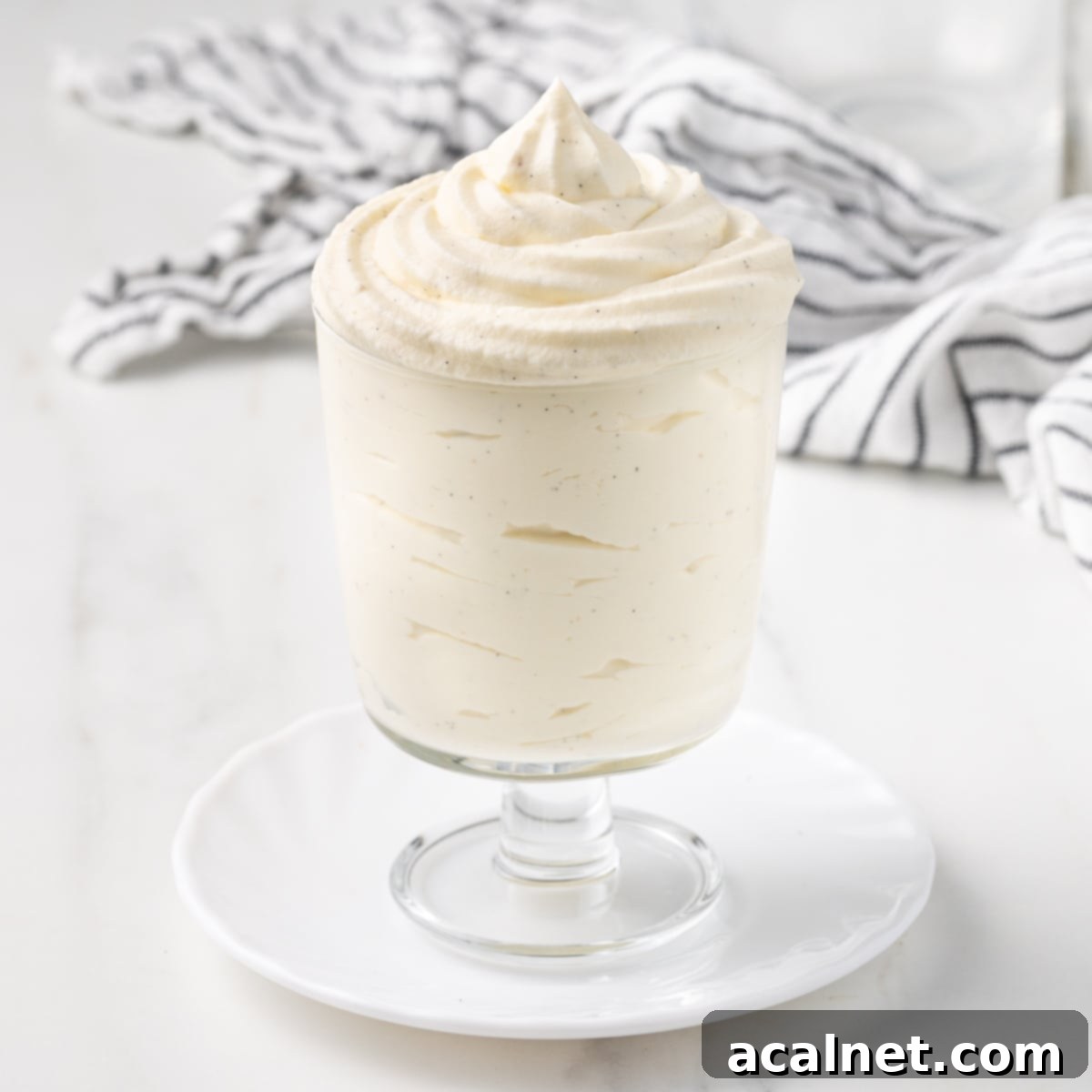
[feast_advanced_jump_to]
Why You’ll Adore This Easy Chantilly Cream Recipe
Chantilly cream is more than just a topping; it’s a simple yet profoundly delicious enhancement that elevates countless desserts, cakes, and even breakfast dishes. Its ethereal lightness and delicate sweetness transform ordinary treats into extraordinary culinary experiences.
This recipe stands out for its incredible simplicity and speed. You’ll only need **three essential ingredients** (or two, if you opt to skip the vanilla for a pure sweetened cream), a bowl, and an electric hand mixer or stand mixer equipped with a whisk attachment. In approximately **15 minutes**, you can create a luxurious, homemade Chantilly cream that will impress everyone.
What is Crème Chantilly? Understanding This Classic French Delight
**Chantilly cream**, or **Crème Chantilly** in its original French, is essentially a sweetened whipped cream, typically flavored with vanilla. It’s renowned for its delicate texture and is a staple in French patisserie. This versatile cream serves as a beautiful topping or a luscious filling for a myriad of desserts. Imagine it nestled inside light and airy Choux buns, spread generously over delicate Crêpes or fluffy waffles, dolloped over vibrant fresh fruits, gracing a slice of pie, or even melting slowly into a warm cup of hot chocolate or coffee.
The intriguing name “Chantilly” is often associated with the grand Chantilly Castle (Château de Chantilly) in France, where it’s fabled to have been first served by the castle’s chef, François Vatel, in the 17th Century. However, culinary historians often credit the cream’s initial invention to Italy, suggesting it was brought to the French court by Catherine de’ Medici in the 16th century. Regardless of its exact origins, Crème Chantilly has undeniably become a beloved symbol of refined French baking, celebrated for its simple elegance and irresistible taste.
Essential Ingredients for Perfect Chantilly Cream
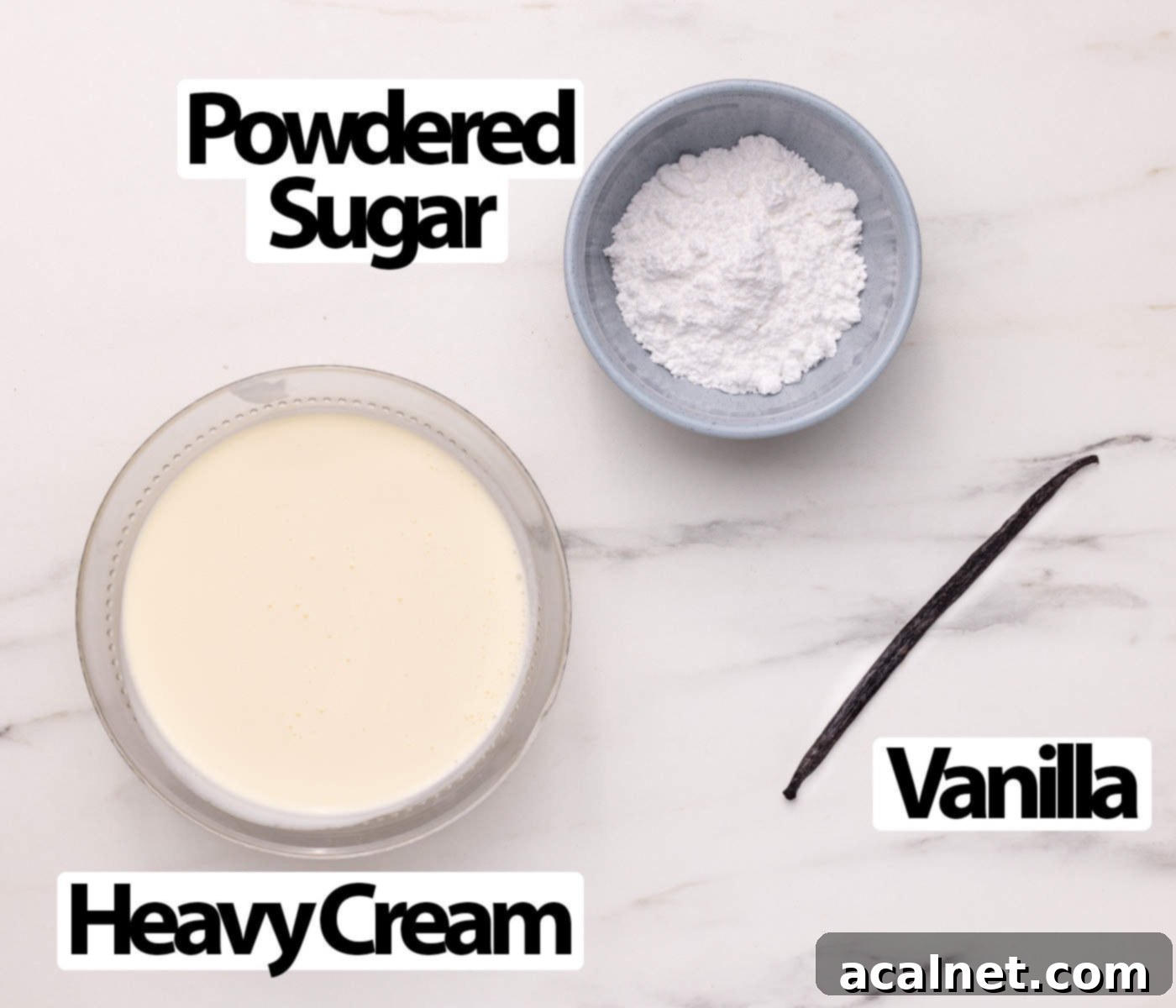
Scroll down to the recipe card below for all exact quantities and detailed instructions.
What goes into the perfect Chantilly Cream:
- Cream: The foundation of your Chantilly! You’ll need heavy whipping cream (commonly found in the US & UK) or thickened cream (in Australia). The absolute most critical factor is that your cream contains at least **35% fat**. Any less, and the cream simply won’t whip properly and hold its volume, as the fat content is essential for stabilizing the air bubbles created during the whipping process.
Note for Australia: Many thickened creams available in supermarkets may contain added stabilizers or thickeners like gelatine. For the best whipping results and a purer texture, I personally recommend using a thickened cream that does not contain gelatine. For this specific recipe, I found excellent results with the Coles brand.
- Icing or Powdered Sugar: This superfine sugar is the ideal choice for Chantilly cream. Its incredibly fine texture ensures that the sugar grains dissolve completely into the cream, preventing any undesirable grainy mouthfeel. Icing sugar that includes a very small amount of cornstarch (or another anti-caking agent) is perfectly acceptable and can even contribute to a slightly more stable cream. While you *can* use caster sugar, powdered sugar undeniably yields the smoothest and most luxurious result.
- Vanilla: For an unparalleled, rich flavor, a fresh vanilla bean is always my top recommendation. The tiny specks of vanilla caviar add both visual appeal and intense aroma. If a fresh bean isn’t available, high-quality vanilla bean paste is an excellent second choice, providing a similar depth of flavor. As a third option, vanilla extract can also be used, though its flavor might be slightly less pronounced.
Exciting Flavor Variations for Your Chantilly Cream
While classic vanilla Chantilly cream is undeniably delicious, it’s also a fantastic base for creativity! You can infuse your cream with a multitude of delightful flavors to match any dessert or occasion. Here are some ideas:
- Chocolatey Delights: Incorporate **cocoa powder** for a rich Chocolate Whipped Cream, or gently fold in cooled **melted chocolate** (dark, milk, or white) to create a luxurious chocolate Chantilly cream.
- Zesty Citrus: Brighten your cream with finely grated **citrus zest** from lemons, limes, or oranges for a refreshing twist.
- Fruity Infusions: Fold in smooth **fruit purées** such as strawberry, raspberry, or blueberry for natural sweetness and color. Just be sure the purée is well-chilled and not too watery.
- Nutty & Minty: Experiment with **flavoring extracts** like almond for a subtle nutty note, or peppermint for a festive, cool sensation.
- Adult Indulgences: Add a splash of your favorite **alcohol** such as Grand Marnier for an orange liqueur kick, brandy for warmth, or rum for a Caribbean flair. Start with a small amount and adjust to taste.
How to Make Crème Chantilly: A Simple Step-by-Step Guide
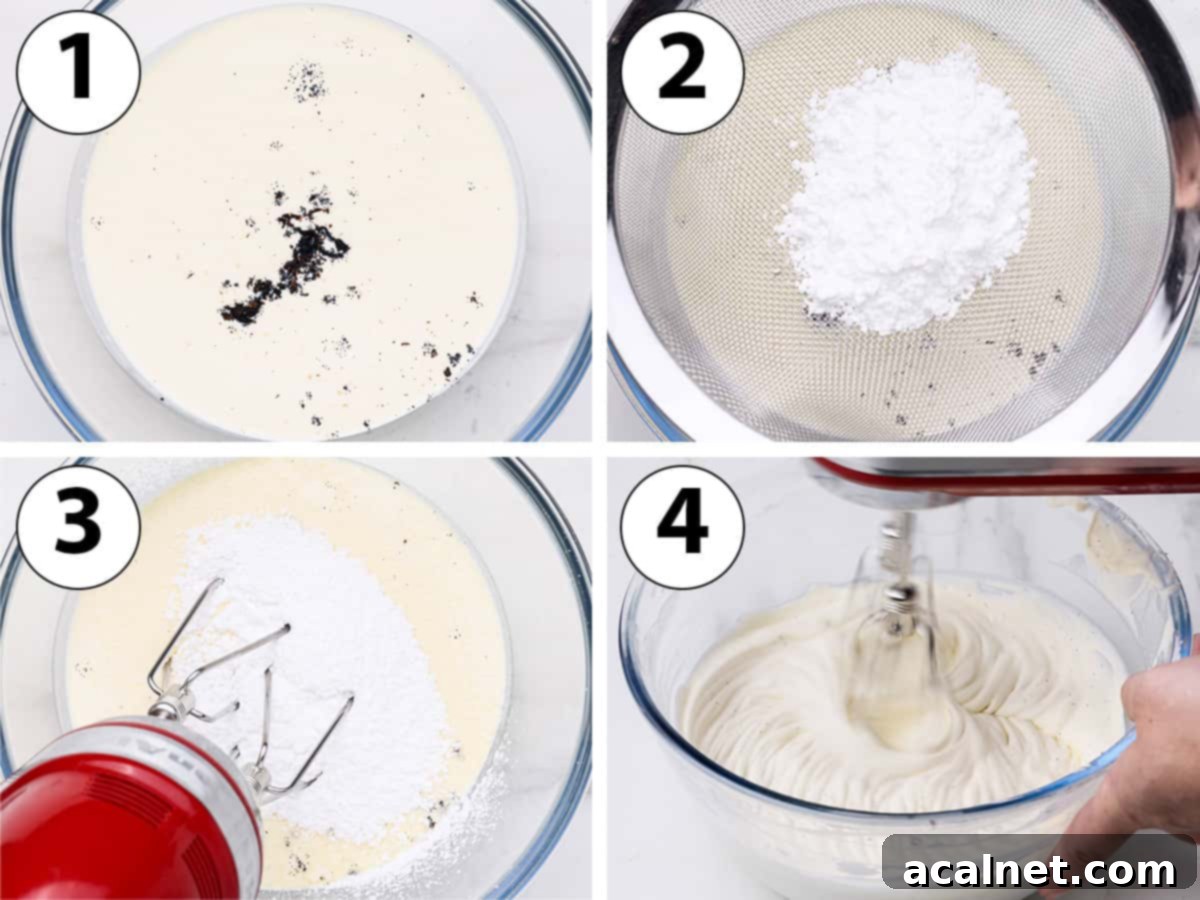
For the best results, ensure both your ingredients (especially the heavy cream) and your utensils (your mixing bowl and whisk attachment) are thoroughly chilled. This helps the cream whip up faster and achieve greater volume.
- Photo 1: Combine Ingredients Place your very cold heavy whipping cream or thickened cream into a large, cold mixing bowl. If using a fresh vanilla pod, slice it in half lengthwise, keeping one end attached. Use a small, sharp knife to scrape out the aromatic seeds from both halves and add them directly to the cream. If using an alternative, add 1 1/2 teaspoons of vanilla paste or vanilla extract instead.
To easily cut and scrape a fresh vanilla bean: Lay the bean flat on a cutting board. Using a sharp paring knife, slice down the middle lengthwise, but only about two-thirds of the way, leaving one end intact. Open the bean like a book. Then, using the blunt side of your knife (or the back of a spoon), scrape along the inside of each half to collect all the precious vanilla seeds. Transfer these seeds to your cream mixture. Remember to save the scraped pod to make your own vanilla extract or infuse sugar for future baking projects!
For a visual guide on how to prepare a vanilla bean, you can refer to the video embedded in the recipe card below.
- Photo 2: Add Sugar Sift the powdered sugar evenly over the cream and vanilla. While the sugar can technically be added at any point during the whipping process, I find it easiest to incorporate it right from the start. This ensures it dissolves completely and integrates smoothly into the cream.
- Photo 3: Begin Whipping Using your electric mixer set to a medium to medium-high speed, begin whisking the cream mixture. Continue to whip for approximately 5 minutes. During this time, the cream will gradually start to thicken and increase in volume. You’ll begin to notice soft waves or distinct swirl patterns forming on the surface of the cream as you whip.
Keep in mind that the exact whipping time can fluctuate depending on several factors, including the precise fat content of your cream and the specific speed and power of your mixer. Always prioritize the visual texture and consistency of the cream over strict timing!
- Photo 4: Achieve Medium Peaks Reduce your mixer speed to medium-low and continue whipping until the cream reaches medium peaks. This stage typically takes only about 30 seconds to 1 minute after soft peaks have formed – it happens quickly! At this point, you can even switch to a hand whisk for better control, which is an excellent way to prevent over-whipping. The Chantilly cream should hold its shape gracefully on the whisk, forming soft, gentle peaks, yet still remain relatively soft and slightly loose, maintaining its characteristic airiness.
In French Pastry tradition, and in my personal opinion, Crème Chantilly is best when whipped to medium peaks. This preserves its signature light and fluffy texture, which is crucial for its delicate nature. Pushing it to stiff peaks can often result in a cream that feels lumpy or grainy, detracting from its elegance.
If you require a cream with a firmer, more stable consistency suitable for stiff frosting, intricate piping, or a robust cake filling, I highly recommend opting for a “stabilised Chantilly Cream” (see the dedicated chapter below) by incorporating mascarpone, rather than over-whipping the cream itself.
- Once your Chantilly cream is ready, use it immediately for the freshest taste and texture. If not using right away, transfer it to an airtight container and place a piece of plastic wrap directly on the surface of the cream to prevent a skin from forming and keep it chilled in the refrigerator until ready to serve.
Understanding Whipping Stages: From Soft Peaks to Stiff Peaks
Mastering the various whipping stages is key to achieving the perfect consistency for your Chantilly cream, ensuring it’s light, airy, and exactly right for its intended use. Here’s what to look for:
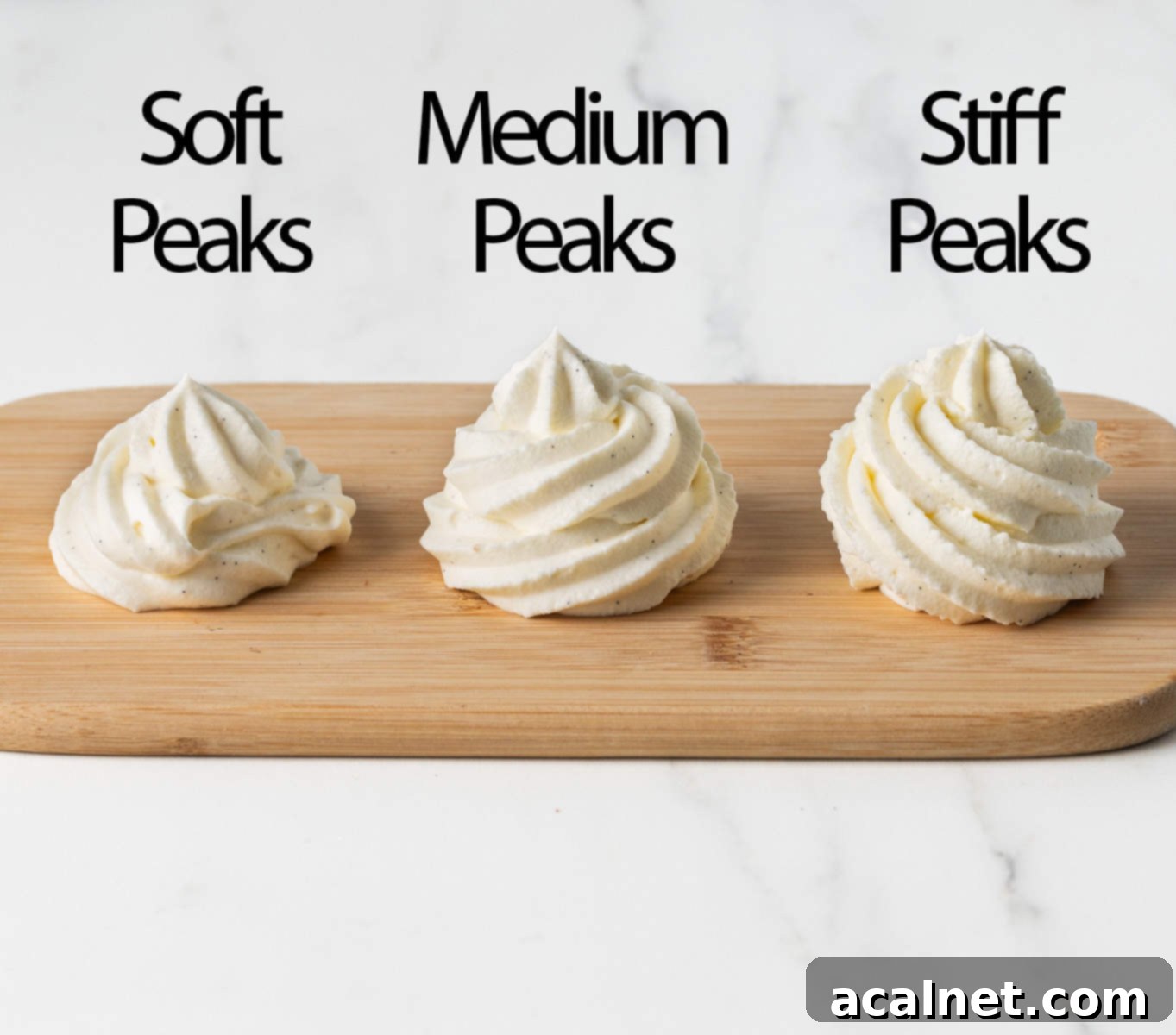
- Stage 1: Soft Peaks – Typically achieved after about 5 minutes of whipping.
At this stage, the cream has noticeably thickened and increased in volume. When you lift the whisk, the peaks will stand up momentarily before gently curling over, resembling soft waves. The whipped cream can hold a loose shape, but it’s still quite fluid and too light to be piped for decorative purposes. It’s perfect for folding into other delicate mixtures.
- Stage 2: Medium Peaks – Reached quickly, often just 30 seconds to 1 minute after soft peaks.
This is the ideal consistency for authentic Crème Chantilly! The cream is firm enough to hold its shape well when the whisk is lifted, forming distinct, yet still slightly pliable, peaks that don’t flop over. It maintains a wonderful lightness and fluffiness, with just a hint of a creamy, ever-so-slightly runny texture. It’s perfect for piping, spreading, or dolloping as a delicate topping that remains soft on the palate.
- Stage 3: Stiff Peaks – Achieved about 1 minute after medium peaks.
Here, the cream becomes very firm and stable, holding its shape exceptionally well with sharp, defined peaks that stand straight up when the whisk is lifted. However, at this point, the texture often begins to turn slightly grainy or even lumpy. For true Chantilly cream, this is generally considered over-whipped. Traditional Chantilly is meant to be light and fluffy, not a dense, stable frosting. While suitable for some applications requiring rigid structure, it sacrifices the delicate mouthfeel inherent to Chantilly. If you need a sturdier cream, consider using a stabilized version instead of over-whipping.
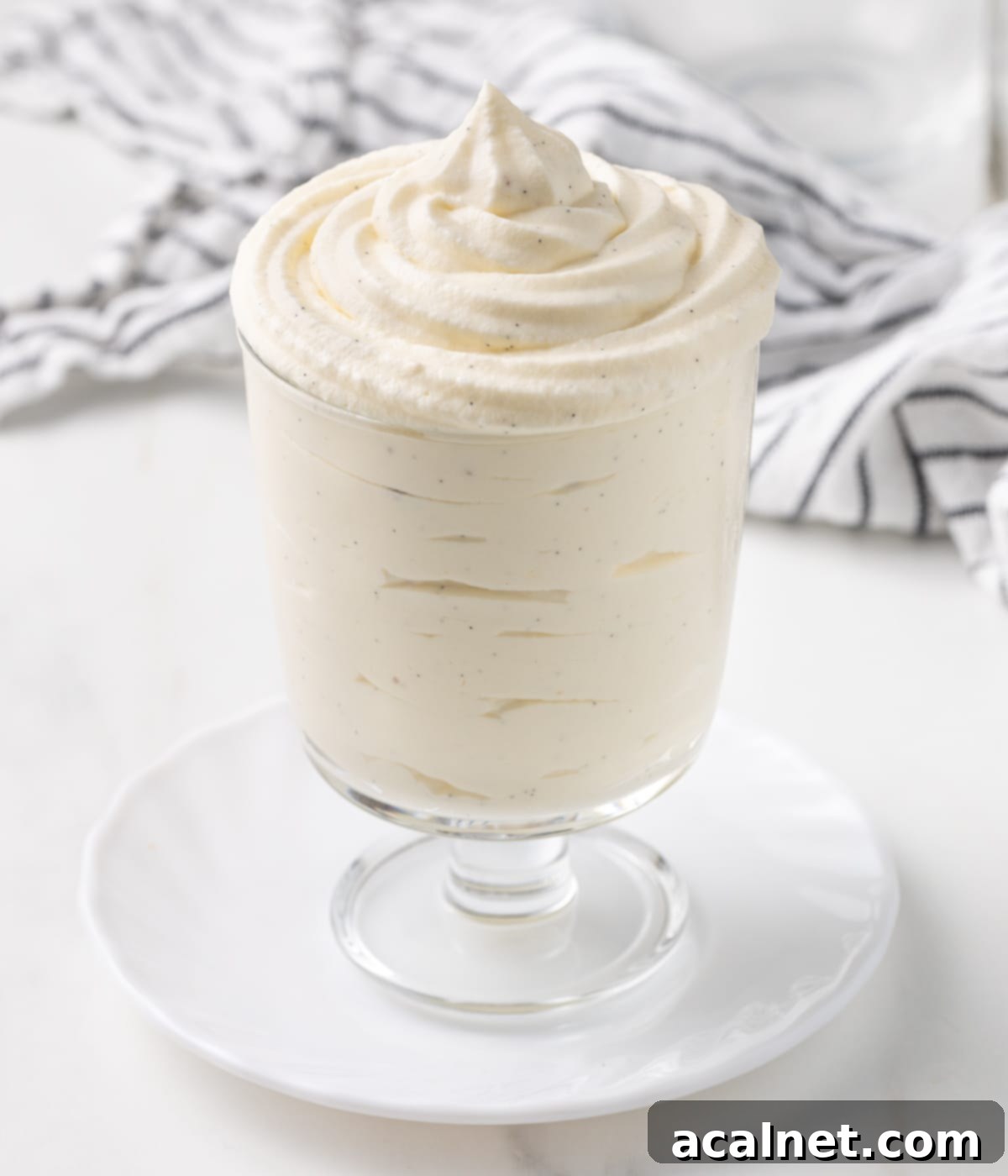
Chantilly Cream Recipe FAQs
The distinction between Chantilly Cream and regular whipped cream is quite subtle but important for traditionalists. Essentially, Chantilly cream is a type of whipped cream that is specifically sweetened and typically flavored, most commonly with vanilla. Whipped cream, on the other hand, refers to pure, plain cream that has been whipped until it thickens and increases in volume, without any added sugar or flavoring. It’s often used as an ingredient to lighten other preparations, such as Diplomat Cream, mousses, or to add volume to batters.
To successfully make whipped cream or Crème Chantilly, the cream must contain a minimum of **35% milk fat**. This fat content is absolutely crucial because the fat globules are what stabilize the air bubbles introduced during whipping. Without sufficient fat, the air bubbles will quickly collapse, causing the whipped cream to deflate and become runny. The types of cream commonly used for this are heavy whipping cream (in the US & UK) or thickened cream (in Australia).
Contrary to popular belief and some modern interpretations, authentic Chantilly Cream is intended to be quite light and airy, with a delicate, slightly loose consistency – sometimes even a touch runny. It’s a common mistake to over-whip it to a very stiff texture. In classic French Pastry, Crème Chantilly is not typically used as a very stable, rigid frosting. Instead, it’s cherished for its fluffy, ethereal quality, serving as a delicate dessert topping or a soft, pillowy pastry filling that melts in your mouth.
Absolutely, you can whip cream by hand! While it certainly requires more time, effort, and arm strength compared to using an electric mixer, it’s a perfectly viable method. Using a large whisk and a cold bowl (perhaps even set over an ice bath) can help speed up the process. A small tip: cream whipped by hand sometimes tends to be slightly less stable than cream whipped with an electric mixer. This is because hand-whipping often creates air bubbles that are a bit more uneven in size, leading to a slightly less uniform structure.
How to Make Stabilized Chantilly Cream for Extra Hold
For more in-depth information, including precise ingredient ratios and additional tips, be sure to check out my detailed Mascarpone Whipped Cream recipe!
If your culinary project demands a cream that holds its shape beautifully for extended periods – perhaps for a sturdy cake filling, an elegant frosting, or intricate piping work – then a **stabilized Chantilly cream** is your answer. The best way to achieve this enhanced stability isn’t by over-whipping the cream (which can lead to a grainy texture), but by introducing a simple, yet highly effective ingredient: **mascarpone cheese**!
Mascarpone cream is an Italian cheese known for its incredibly high fat content, typically around 45%, significantly higher than the 35% in most heavy creams. This increased fat content acts as a natural stabilizer, helping the cream maintain its structure and loft much more effectively without needing to be excessively whipped. The mascarpone also adds a rich, velvety mouthfeel and a subtle tang that complements the sweetness of the Chantilly.
To prepare a stabilized Chantilly cream, simply substitute 25% to 30% of your heavy cream with mascarpone cream. The remainder of the recipe – including the whipping method and the addition of powdered sugar and vanilla – remains exactly the same. This small adjustment will yield a Chantilly cream that is both light and fluffy, yet boasts superior stability for all your decorating and filling needs.
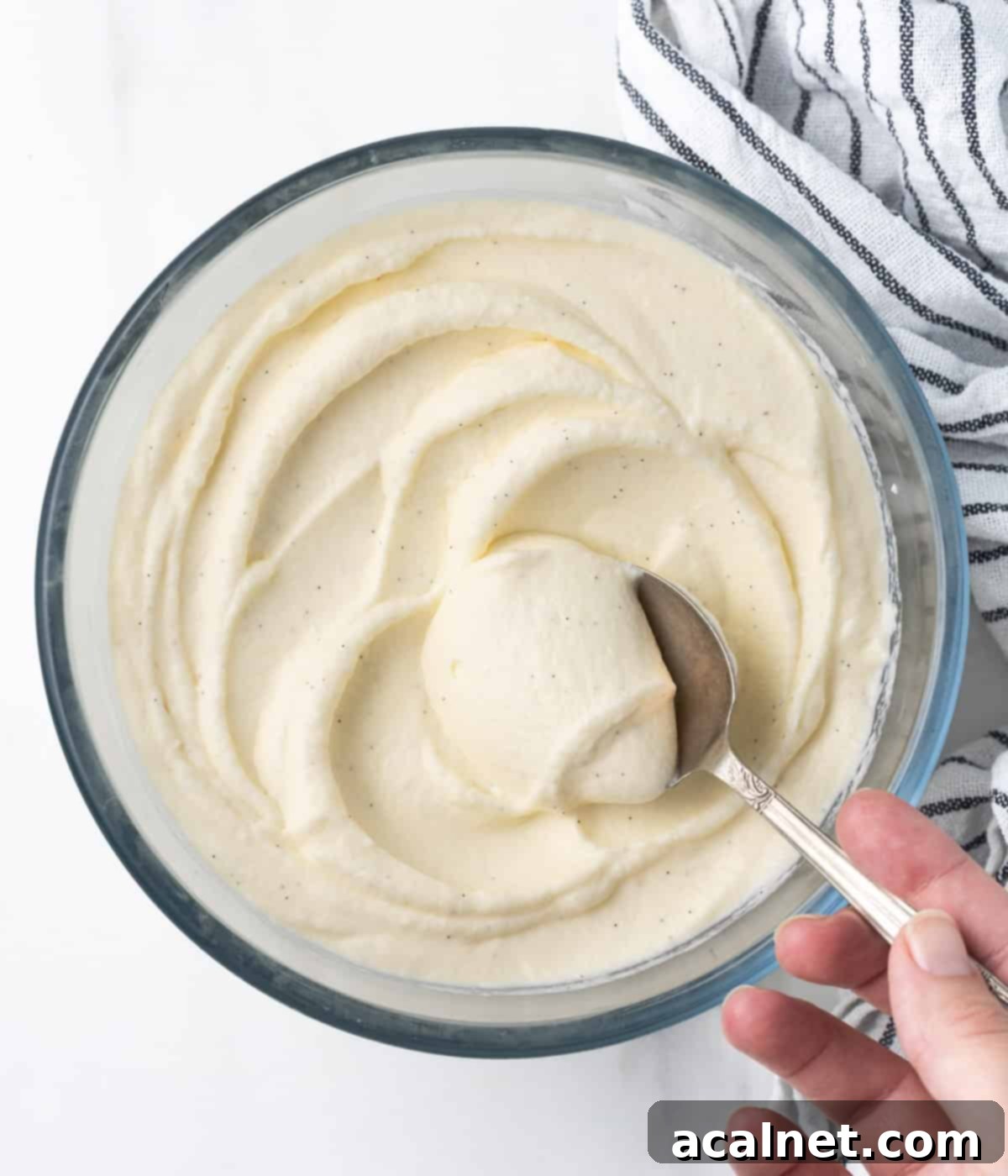
Tips & Troubleshooting for Perfect Whipped Cream
Even though making Chantilly cream is straightforward, a few common issues can arise. Here’s how to prevent them and fix them if they do:
Help! My Cream Isn’t Whipping!
It’s normal for heavy cream to take a little time to start thickening; don’t panic if it doesn’t stiffen immediately. However, if you’ve been whipping it on medium to high speed for several minutes and it remains completely liquid, the most common culprit is often a low fat content. For successful whipping, your cream absolutely needs to have at least 35% fat. Always check the label before you buy!
My Chantilly Cream is Too Thin. What Now?
If your Chantilly cream is thinner than desired, simply continue whipping it for a bit longer. You can also slightly increase your mixer’s speed. Keep a very close eye on it, as the transition from soft to medium to stiff peaks can happen rapidly. The key is to whip just enough without overdoing it!
My Cream is Lumpy or Grainy. What Happened?
A lumpy or grainy texture is the tell-tale sign of over-whipped Chantilly cream. This means you’ve whipped it past the ideal medium peak stage, and the fat molecules are starting to clump together, moving towards becoming butter. While it’s not ideal for delicate Chantilly, it’s still salvageable!
How to Fix Over-Whipped Crème Chantilly
Don’t despair if your cream has become lumpy! To rescue over-whipped Chantilly cream, gently add a small amount of cold, liquid cream (unwhipped) into the mixture. Carefully fold it in with a spatula or whisk by hand. Continue adding small increments of liquid cream and folding until you achieve your desired smooth, soft consistency. If, after adding liquid cream, it becomes too soft, you can very lightly whip it again by hand with a whisk for just a few seconds until it stiffens slightly.
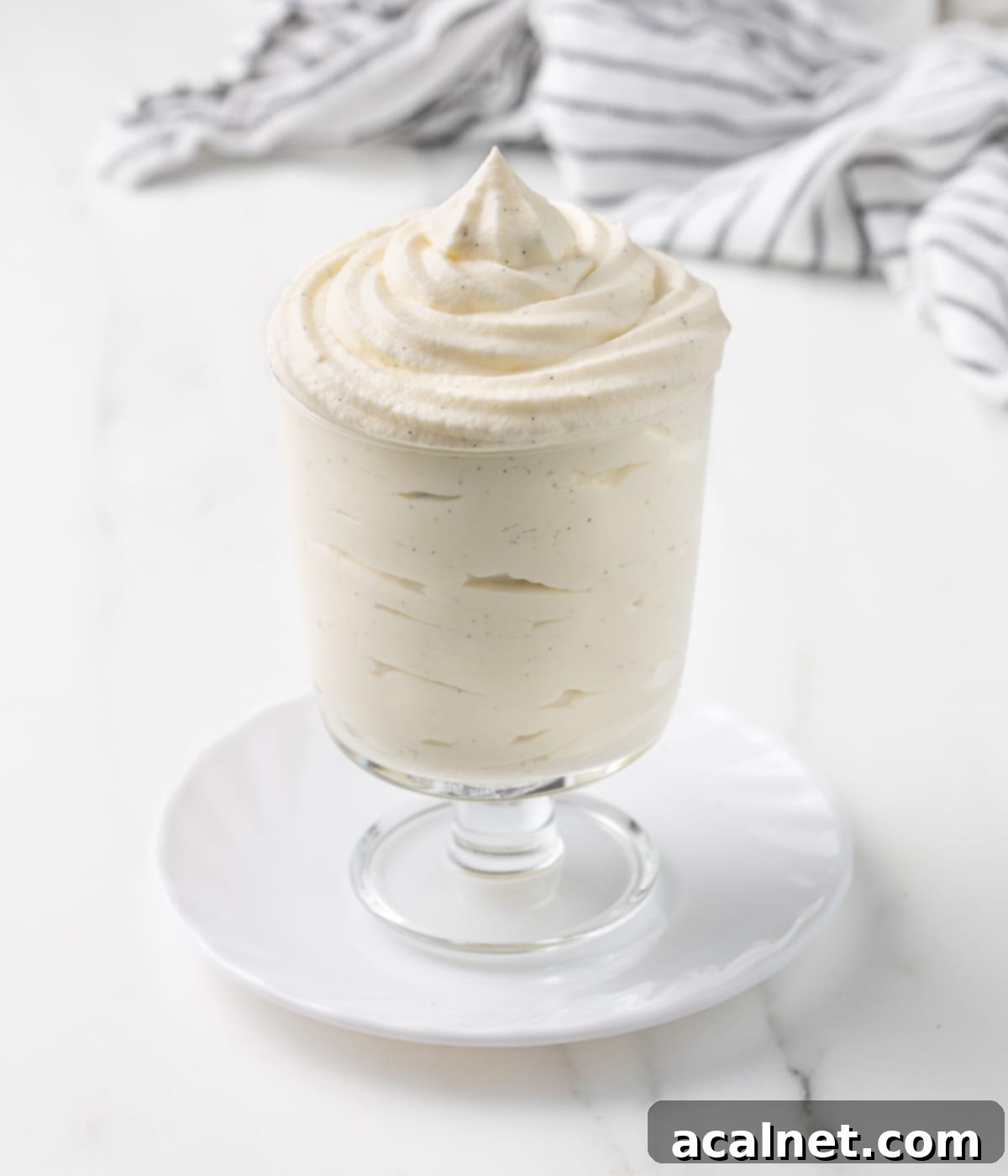
Creative Ways to Enjoy Your Homemade Crème Chantilly
The beauty of Crème Chantilly lies in its incredible versatility. Here are just a few ways to incorporate this delightful vanilla whipped cream into your meals and desserts:
- For Breakfast & Brunch: Make your mornings special by dolloping Chantilly cream over fluffy pancakes, light and airy Croissant French Toast Bake, classic waffles, or decadent Brioche French Toast. It’s also an exquisite filling for sweet Crêpes, especially when paired with fresh berries or sliced bananas.
- Enhancing Cakes & Cupcakes: A generous serving of Chantilly cream is heavenly over a slice of rich Chocolate Fondant Cake or a zesty Lemon Ricotta Cake. Spread it over a simple sponge cake and top with a medley of fresh berries for a light and refreshing dessert, or use it as a delicate counterpoint to a rich Biscoff Cheesecake.
- Luxurious Pastry Fillings: Crème Chantilly is the quintessential filling for many French pastries. Use it to fill delicate Choux à la Crème (cream puffs) or to add an airy lightness to Chouquettes.
- Dressing Up Desserts: Lightly flavored with citrus zest, a hint of espresso powder, or even a dash of liqueur, Chantilly cream is perfect piped over mousses like a bright Orange Mousse or a decadent Chocolate Orange Mousse. It complements rich, creamy desserts such as Coffee Panna Cotta and Chocolate Panna Cotta, adds a beautiful finish to a Pavlova Wreath, or simply crowns a scoop of ice cream or a bowl of vibrant fresh fruits.
Storing & Freezing Homemade Chantilly Cream
To maintain its delicate texture and freshness, Crème Chantilly should always be stored in the refrigerator and ideally consumed within 2 to 3 days. Beyond this period, it will gradually begin to deflate and may become a bit watery. The optimal way to store Chantilly cream is in a bowl or an airtight container, ensuring that a piece of plastic wrap directly covers (and touches) the surface of the cream. This prevents a skin from forming and protects it from absorbing refrigerator odors.
Unfortunately, this recipe for classic Chantilly cream does not freeze well. The delicate emulsion tends to separate upon thawing, resulting in a grainy, watery texture that loses its light and airy appeal. For best results, always make Chantilly cream fresh when you plan to use it.
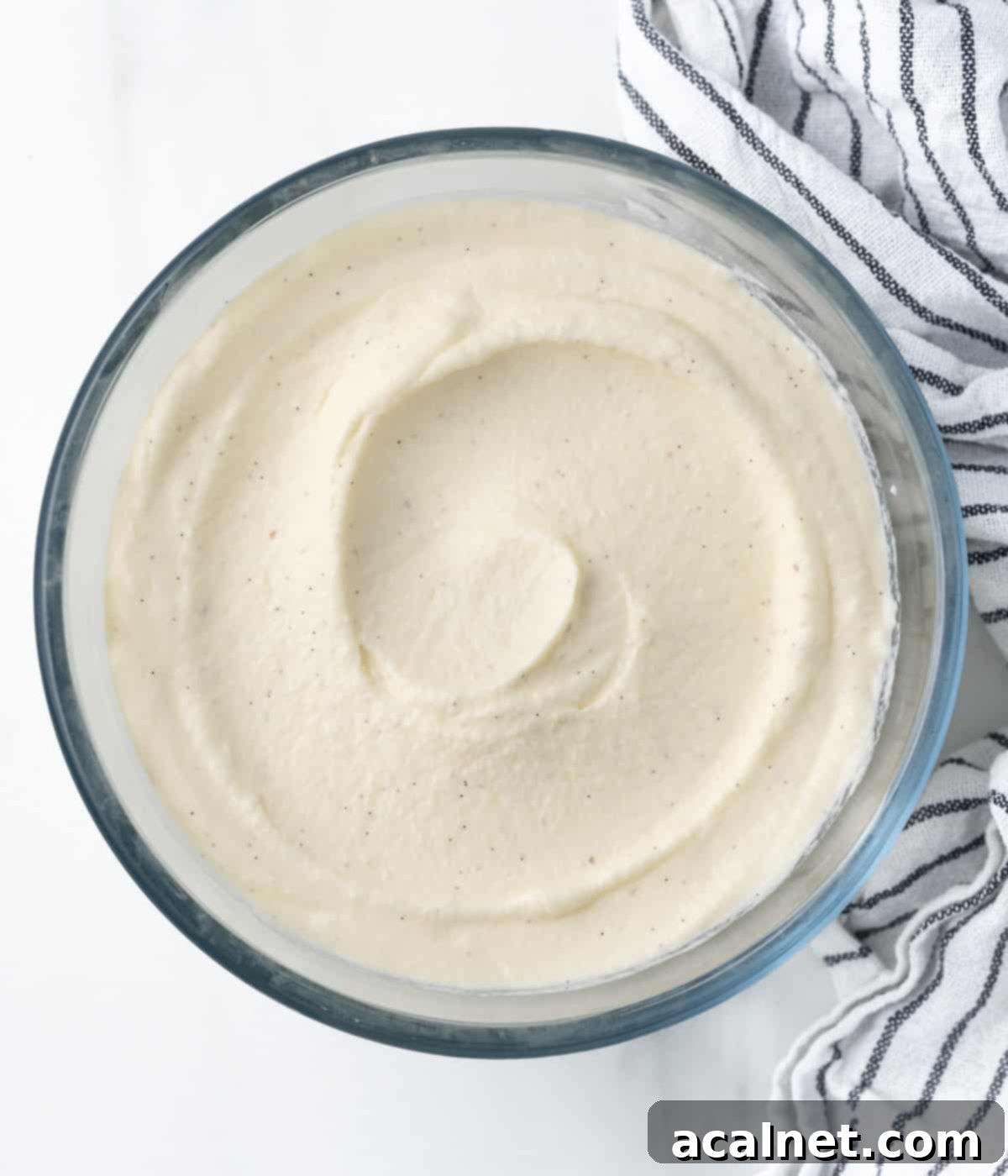
Explore More Classic French Creams and Frostings
If you’ve enjoyed mastering Crème Chantilly, dive deeper into the world of French patisserie with these other essential cream recipes:
- Crème Pâtissière (Pastry Cream): The foundational cream for countless French desserts.
- Chocolate Pastry Cream: A decadent variation of crème pâtissière.
- Bavarian Cream (Crème Bavaroise): A lighter, gelatin-set cream often found in layered desserts.
- Pistachio Pastry Cream: A vibrantly flavored crème pâtissière.
- Chocolate Whipped Cream: A richer, more stable version of chocolate Chantilly.
- Chocolate Crémeux (Crèmeux au Chocolat): A luxurious, intensely flavored chocolate cream.
- Diplomat Cream (Crème Diplomate): A lighter, airier cream made by folding whipped cream into pastry cream.
- Crème Anglaise (Custard Sauce): A pourable vanilla custard sauce.
- Namelaka: A silky-smooth, intensely flavored ganache-like cream.
- Whipped Ganache Frosting: A rich and stable frosting made from chocolate ganache.
- Mousseline Cream (Crème Mousseline): A rich, buttery cream made by whipping softened butter into crème pâtissière.
Loved This Recipe?
We’d love to hear from you! Leave a comment below to share your experience, and don’t forget to tag us on Instagram @a.baking.journey with a photo of your beautiful creation!
Recipe Card: Classic Crème Chantilly
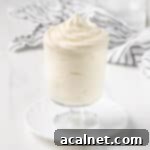
Crème Chantilly (Chantilly Cream)
Print Recipe
Ingredients
- 400 ml Heavy Whipping / Thickened Cream, min 35% fat content
- 30 gr Icing or Powdered Sugar
- 1 fresh Vanilla Bean, or 1 1/2 teaspoon Vanilla Paste
Instructions
- Before starting, make sure that both the cream and utensils (large bowl with hand mixer attachment or stand mixer bowl and whisk attachment) are cold.
- Place the heavy whipping cream / thickened cream in a large bowl. Scrape the seeds out of a fresh vanilla pod (see note 1) and add it to the cream. Alternatively, use 1 1/2 teaspoon vanilla paste or vanilla extract.
- Sift the powdered sugar over the cream and vanilla.
- With your mixer set on medium speed to medium-high speed, starting whisking the cream. Continue to whip for about 5 minutes or until the cream starts to thicken and you can see soft waves or swirl pattern appear on top of the cream (see note 2).
- Reduce the mixer speed to medium low (or switch to a hand whisk to avoid over-whipping the cream) and continue to whip until you reach medium peaks – about 30 seconds to 1 minute (yes, it goes fast!). The Chantilly cream should hold its shape on the whisk but still be relatively soft and loose.
- I personally think that Chantilly Cream should only be pushed to medium peaks to remain light and fluffy, rather than stiff peaks that can easily turn lumpy or grainy. If you want to use this cream as a stiff frosting / filling, or a cream that can be piped and hold its shape well, I highly recommend making “stabilised Chantilly Cream” (see note 3) rather than whipping the cream to stiff peaks.
- Use straight away or keep in the fridge, covered with plastic wrap touching the surface of the cream, until ready to use (best within 24 hours).
Video
Would you like to save this recipe?
We’ll email this post to you, so you can come back to it later!
Notes
- To cut and scrape a fresh vanilla bean: slice it in half lengthwise, keeping one of the end attached. Using a small sharp knife, scrape the seeds contained inside the two lengths the pod and transfer the seeds inside the bowl. Make sure to keep the remaining pod to make your own vanilla extract or flavour sugar for example!
- The exact whipping time can vary based on the ingredient used (exact fat content of the cream) and exact speed of your mixer. Make sure to refer to texture rather than time.
- To make stabilised Chantilly Cream, simply replace 25 to 30% of the heavy cream with mascarpone cream. Mascarpone has a much higher fat content than heavy cream (about 45% vs 35%), which will help stabilise the cream and make it hold its shape much better without requiring extra whipping.
Nutrition (per serving)
